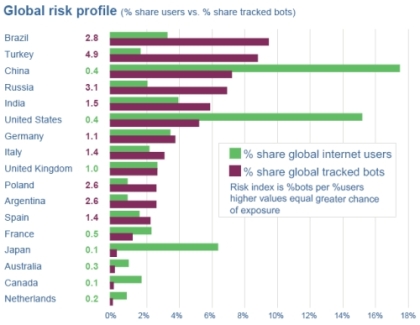Emerging markets at greater risk of cybercrime

Emerging markets such as the Bric (Brazil, Russia, India and China) economies are at higher risk of being exposed to cyberthreats, according to a new report from security vendor MessageLabs.
Released on Wednesday, the MessageLabs Intelligence: 2008 Annual Security Report noted that Brazil had the world's biggest share of global bots, at nearly 10 percent. Turkey and China were ranked number-two and number-three, with respective shares of about nine percent, and over seven percent. Russia and India were also among the top five.
Turkey, however, emerged as most at-risk of exposure to cyberthreats, according to the report. It had a score of 4.9 on an index indicating the global risk exposure, which also takes into account the internet population of individual countries. Russia had a score of 3.1, Brazil 2.8 and India 1.5. With its large internet population, China's index score was a mere 0.4, comparable with that of the US.
China's top-level domain, '.cn', is also the second-most blocked domain containing malware, after the '.com' top-level domain, which accounted for more than half (53.9 percent) of malicious domains blocked. Malicious sites registered under the .cn top-level country code accounted for 17.4 percent of sites blocked, while third-place Russian '.ru' domains accounted for 12.2 percent.
The report pointed out that the increasing demand for .cn domains puts the country at risk of cybercrime. Citing statistics from the China Internet Network Information Center, MessageLabs said there are 1.92 million websites hosted in China, with 71.3 percent hosted under the .cn top-level country code domain.
MessageLabs, which is now part of Symantec, also reported that an average of 53 Trojan attacks were intercepted daily last year, with a peak of 78 a day in April. This was five times higher than the 10 daily in 2007.
The messaging security specialist also warned that in the year ahead, malware 'mashups' will become more common. Web 2.0 would pave the way for contextual malware, which "can consolidate multiple dynamic data streams to create a malicious environment from a number of diverse, unrelated sources", said MessageLabs. Malware will also become more disposable as cybercriminals look for newer and faster ways to change their attack code to make it undetectable by improved antivirus systems.
Other MessageLabs predictions about the security landscape in 2009 included the following:
- Cloud-based computing environments, in which data and information are stored or processed on servers that hold up the internet, will become increasingly targeted in 2009.
- Phishing attacks will focus on exploiting vulnerable DNS domains and websites, and less on the traditional approach of hosting the domains that look like or are a misspelling of legitimate sites.
- Mobile attacks will become more malicious as criminals devise ways to make money by further exploiting these devices. While MessageLabs noted that there were 300 mobile viruses in circulation compared with 400,000 PC-based threats, mobile threats will parallel PC attack numbers.
- Major botnets will find hosting services in countries such as Russia, Brazil or China, precipitating an improvement in botnet technology creating a new vanguard for networks of zombie computers.
Corporate blackmailing on the rise?
Separately, McAfee has predicted that corporate blackmailing will, among other trends, increase in 2009. In its report released on Wednesday, the security vendor said cybercriminals will increasingly use botnets to gather sensitive data on corporate networks and datacentres, blackmail companies or sell on the underground economy. Browser-based attacks will also increasingly be used as the "least-protected vector in order to transfer payload".
